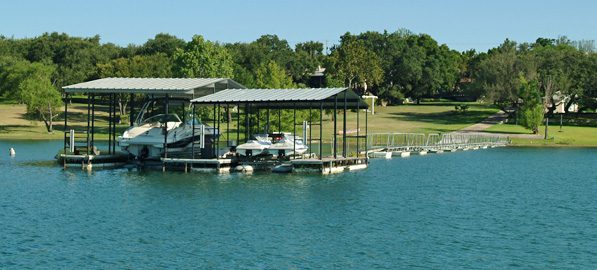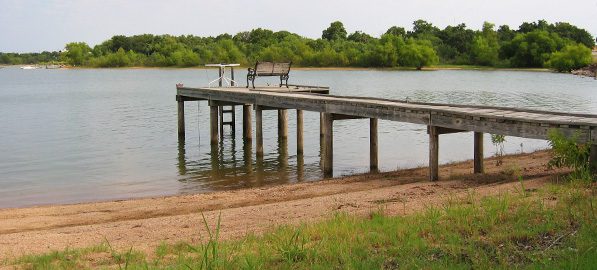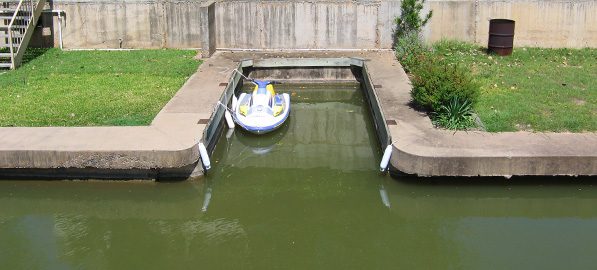Preparing Docks for Floods on the Highland Lakes

FLOATING DOCK

FIXED DOCK

RECESSED DOCK
Tips for preparing your dock
A Sandy Creek flood highlights the importance of prepping docks.
Prepare docks for floods
View a printable version of tips.
Central Texas, dubbed “Flash Flood Alley,” is often home to sudden, unexpected rains and flash floods. Regular maintenance is essential to keep the more than 8,700 floating, fixed and recessed boat docks on the Highland Lakes safe during flooding. Flash floods occur with little warning, and a dock can easily break loose and become a hazard if it is not properly maintained to accommodate stresses created by wind, waves, current, boat wakes and fluctuating lake levels.
Dock owners are responsible for damage caused by their docks breaking loose, washing away or presenting a hazard to navigation.
Securing floating docks on lakes Travis, Buchanan and LBJ
Floating docks are at higher risk than fixed and recessed docks during floods. LCRA estimates there are more than 3,700 floating docks on lakes Travis and Buchanan, with a few on Lake LBJ.
The easiest way to maintain a boat dock is to hire a qualified boat dock contractor, especially for part-time lake residents who may not be on site as lake levels rise and fall.
Position the anchors: Keep docks close to shore. Most floating docks have four anchor points — two on shore and two off shore. To prepare for a flood, dock owners should double-up cables and anchor downstream, closest to the shoreline. No anchors should be upstream. When water comes down the river, docks will then pivot close to shore and away from fast-moving water, debris, logs or loose docks. Docks anchored on all four sides are vulnerable to the brunt of the fast-moving water and can break loose and become a safety hazard.
Anchors and docks should be placed only over property that is owned, leased or controlled by the dock owner. Owners choosing to move their docks to follow receding water during a drought should ensure the docks are not placed on someone else’s property. In addition, owners should understand that moving a dock to follow receding lake levels may result in the dock being more vulnerable to fast-moving flood waters and flood debris.
Stay within the maximum distance from shore: LCRA’s Safety Standards for Residential Docks on the Highland Lakes sets out maximum distances docks may be from shores. The standards apply even when lake levels are low. The shoreline is wherever the water meets the land. Boat docks should never be moved so far that they extend into the middle of the river channel or pose a threat to other boaters. Under the safety standards, the maximum distance docks may be from the shoreline is:
- Lake Buchanan — 150 feet
- Inks Lake — 35 feet
- Lake LBJ — 50 feet
- Lake Marble Falls — 35 feet
- Lake Travis — 100 feet
Install proper lighting: Place solar-powered or battery-operated lights on the dock to make it visible at night. This is especially helpful if the dock has been moved further out in the lake to follow receding lake levels.
Conduct routine maintenance: Inspect the dock’s structure to make sure there are no cracks or other issues that would weaken the dock. This help the dock stay together in the event of a flood.
Check cables: Make sure cables are in good shape and are not frayed or corroded. Damaged cables should be replaced.
Encase flotation: Make sure dock’s flotation foam is encased as required by the Safety Standards for Residential Docks on the Highland Lakes. Encased flotation will help keep sections of the foam from breaking off and will keep the dock from sinking or turning upside down.
Limit loose items: Keep dock free of items such as unsecured lawn chairs, toys and other material that could be swept away by a flood.
There is no guarantee docks won’t be damaged by a flood, but these recommendations will help minimize the risk. LCRA will issue a notice of violation if docks do not meet the Safety Standards for Residential Docks on the Highland Lakes by being too far from the shore, unanchored or adrift.
Maintaining fixed and recessed docks on lakes Inks, LBJ and Marble Falls About 5,000 fixed and recessed docks are on the pass-through lakes (Inks, LBJ and Marble Falls). Floods can cause the elevation of these lakes to rise rapidly.
Fast-moving water often carries debris such as trees, brush and other docks that have broken loose. Flood debris can accumulate on the upstream side of a fixed dock, causing an increased stress load. If there is a safe opportunity between rain events, dock owners should use a pole to push debris away from the pilings. Dock owners should only do this when conditions are safe and when wearing a life jacket.
Docks on the Llano, Colorado and Pedernales rivers should be engineered to withstand additional stresses created by flood debris. Where practical, owners should consider installing recessed docks, which offer one of the most effective ways to negate the effects of fast-moving water and provide extra protection from damage during flood events. It is important to keep these slips free of debris as well.
After the flood
After a flood, clean-up can take a few weeks to a few months, depending on the impact of the flood. LCRA urges dock owners to keep safety a priority when working on their docks. Owners should make sure electricity is shut off and wear a life jacket. Drowning is always a potential danger when working near water. LCRA also suggests dock owners consider using professional dock service companies to recover, relocate and repair docks.
Floodgate operations
Floodgate operations along the Highland Lakes can cause water to move quickly downstream, causing swift currents and higher lake levels. Natural bodies of water may contain sandbars and rock outcroppings and other hazards, many of which are near the shore. A dock owner should know what is under their dock.
See the estimated time it takes for water to flow to Mansfield Dam from upper basin locations, and how long it takes to reach downstream locations from Mansfield.
Register your dock
Residential dock owners may voluntarily register their docks with LCRA by contacting Mike Newhouse, Water Surface Management, at [email protected] or 800-776-5272. If a dock breaks loose and is found at another location on the lake, registration may help identify its rightful owner and facilitate its return. All registration information is public information and is subject to the Public Information Act.
Dock owners also can mark their docks with their name, address and contact information, or paint a symbol on their docks. This will help identify docks and locate owners if docks break loose.
Residential docks on Lake Austin are regulated by the City of Austin. Contact the Austin Parks and Recreation Department at 512-974-6737 for information and regulations.


Social Media